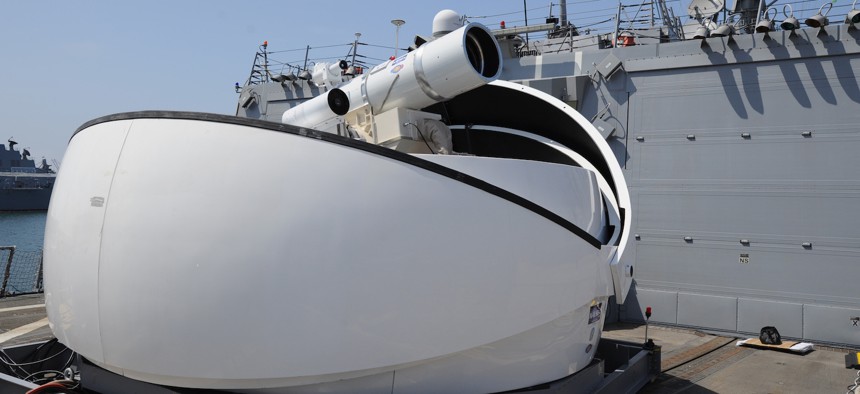PATRICK TUCKER

The U.S. Navy warships shooting down Houthi drones and rockets in recent weeks have generally done so with guns and missiles that are far more expensive than the threats they head off. And notably absent from U.S. officials' statements about the incidents are the next-generation directed-energy weapons the military has spent years developing to do precisely this job.
A recent Congressional Research Service report offers some clues as to why.
The Navy isn't having much trouble swatting down the Houthis' Iranian-made drones, even when they're launched by the dozen. But the Pentagon is beginning to worry about using $11 million interceptor missiles to take out drones that can cost as little as a few thousand dollars
That price disparity is why the military started seeking lasers and other directed-energy weapons, which promise cheap, all-but-unlimited "magazines" to intercept drones in large numbers. The United States has already deployed lasers aboard ships effectively, beginning with the USS Ponce in 2014.
The U.S. now deploys eight 30-kw Optical Dazzler Interdictor Navy, or ODIN, systems on Arleigh Burke-class destroyers. In 2022, it deployed a high-energy laser with integrated optical dazzler and surveillance, or HELIOS laser, (60-kw to 150 kw) aboard the USS Preble. And there are more lasers in development, such as the High Energy Laser Counter, or HELCAP program, and the Layered Laser Defense, or LLD, program.
But there are still technical challenges to scaling lasers up to be able to hit targets, particularly fast targets. While the laser beam itself is literally as fast as the speed of light, at current power levels it takes multiple seconds of tracking to cause enough damage to take down a drone. The Navy and some other parts of the Defense Department are working through those scaling challenges, and proponents say fiber lasers will help overcome those limitations to make them more useful against drones.
But there’s another bureaucratic obstacle to wide deployment, one so paradoxical it could come from Joseph Heller. As the CRS report lays out: “The Navy has been working to develop cost estimates for procurement of future laser weapon systems in order to support Navy programmatic considerations,” but “There are no previous programs of record for shipboard laser weapon systems in the Department of Defense from which to draw historical comparisons, particularly in the area of logistics and life-cycle cost.”
In other words, the Navy can’t acquire ship lasers because it has never acquired large numbers of them before, and therefore doesn’t know how much it might cost.
Right now, the estimates are “a 60 kW class laser with relatively mature beam control and combat system integration at moderate production rates will be approximately $100M [million] in limited quantities. For weapons at greater power and/or beam control complexity, the estimates range up to $200M/unit for lasers in the 250 kW class” according to the report. The takeaway: The United States will wind up paying much more in the short term to save more on missiles.
No comments:
Post a Comment